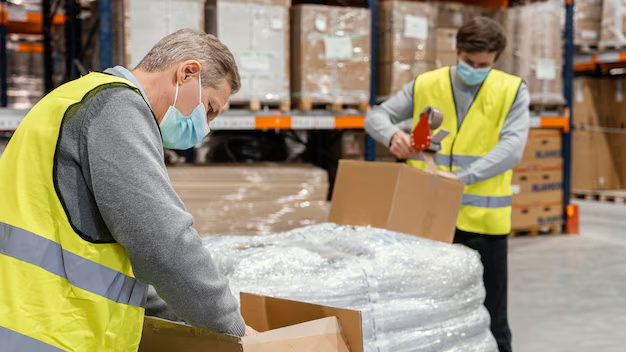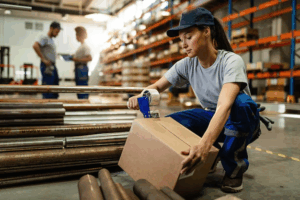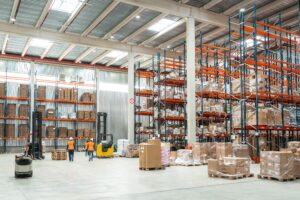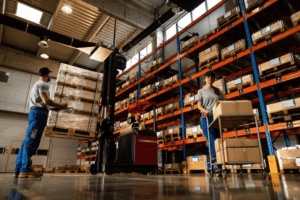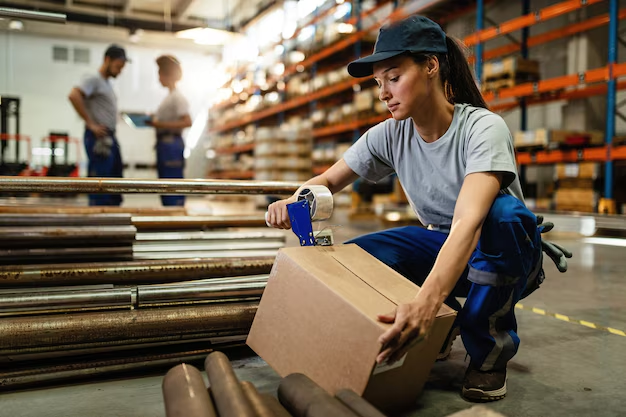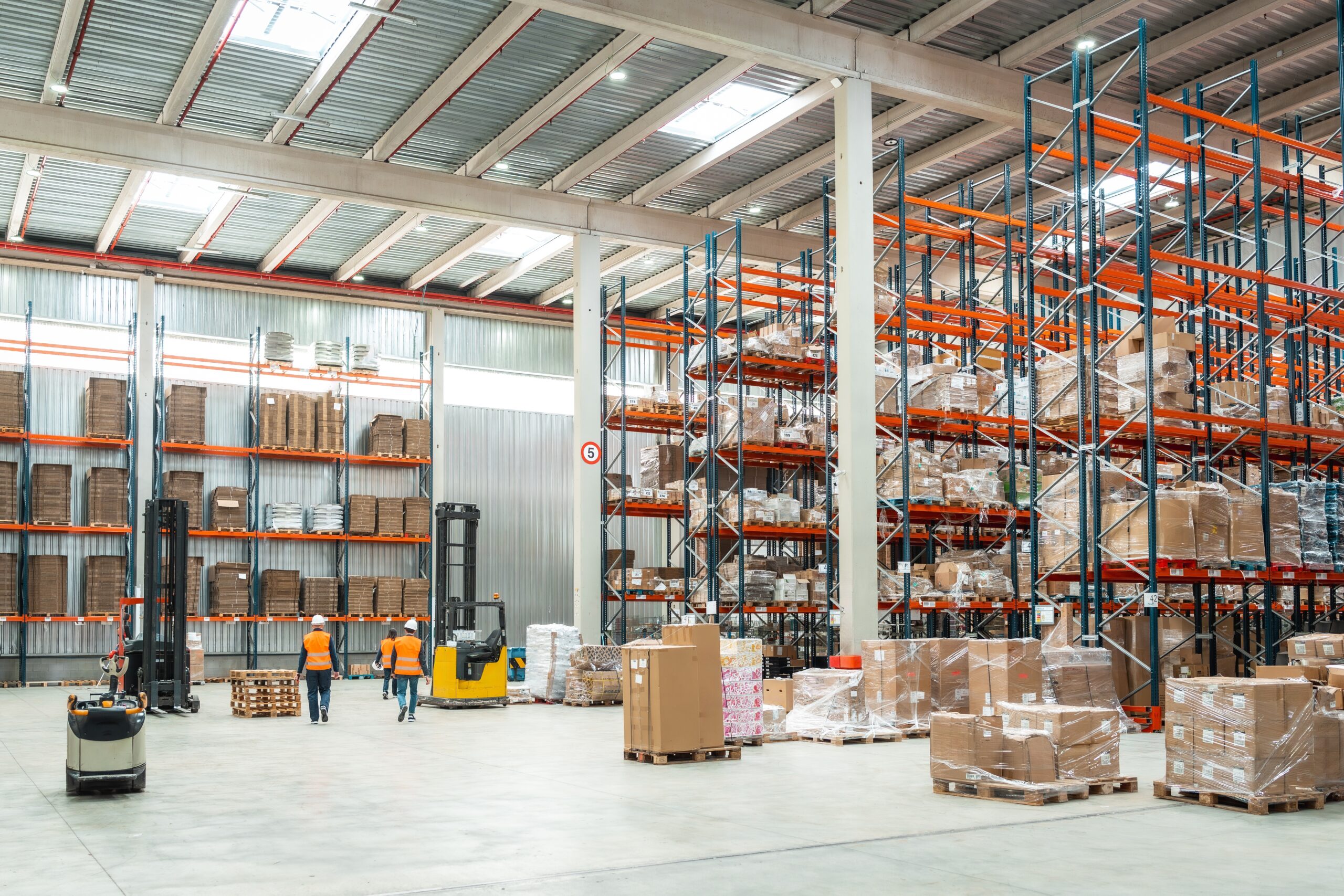Maintaining a safe warehouse environment is essential for any business that handles inventory, whether for Amazon fulfilment, heavy goods, or general storage. Warehouse storage safety is not only critical to protect employees but also ensures the integrity of products, compliance with OSHA regulations, and smooth operational efficiency.
In this article, we will explore essential safety protocols, OSHA compliance requirements, the role of safety training, and how warehouse operations can be structured to minimize risk. We will also highlight best practices for implementing safety programmes and maintaining high standards across all warehouse activities.
Why Warehouse Safety Matters
Warehouses are dynamic environments where staff interact with heavy machinery, inventory, and automated systems. A lapse in safety can lead to:
- Employee injuries or fatalities
- Product damage or loss
- Operational downtime
- Legal consequences for failing to comply with OSHA regulations
Focusing on warehouse safety ensures that staff can perform their duties efficiently while reducing risks and maintaining high productivity. Businesses like Lama Fulfilment prioritise safety to maintain seamless fulfilment operations and protect both staff and inventory.
Key Elements of Warehouse Safety Protocols
Implementing effective warehouse safety protocols requires a comprehensive approach that addresses equipment, staff behavior, and environmental hazards. These elements work together to prevent accidents, protect inventory, and ensure smooth operations. By focusing on structured safety measures, businesses can maintain compliance and promote a culture of safety among employees.
1. OSHA Compliance
OSHA compliance is the foundation of warehouse safety in the United States. OSHA sets standards for:
- Safe operation of forklifts and pallet trucks
- Proper use of personal protective equipment (PPE)
- Hazard communication and handling of chemicals
- Emergency preparedness and fire safety
Compliance with these regulations not only prevents accidents but also avoids costly penalties. Businesses can implement OSHA guidelines by regularly auditing warehouse processes and conducting compliance training.
2. Safety Training Programmes
Safety training is critical to ensuring that staff understand warehouse hazards and proper operational procedures. Effective safety training should include:
- Handling heavy and bulky products safely
- Correct use of forklifts, ladders, and other warehouse equipment
- Emergency evacuation drills and first-aid response
- Safe lifting and manual handling techniques
Ongoing training ensures that employees remain aware of potential risks and are prepared to respond appropriately, reducing workplace incidents.
3. Warehouse Layout and Organisation
An organised warehouse reduces accidents and improves workflow. Key considerations include:
- Clear aisle markings and designated walkways
- Proper shelving and pallet racking
- Ergonomic workstations
- Safe storage of hazardous materials
A proper layout and organisation also contribute to smoother Amazon fulfilment processes, as staff can locate and handle inventory efficiently.
4. Personal Protective Equipment (PPE)
PPE is a vital line of defence in warehouse safety. Standard PPE may include:
- Gloves and protective clothing
- Safety helmets
- High-visibility vests
- Steel-toed boots
- Eye and ear protection
Implementing PPE policies ensures that employees are protected from potential hazards while performing their tasks safely.
5. Equipment and Machinery Safety
Warehouses often rely on machinery for material handling. Ensuring safe operation involves:
- Routine inspections and maintenance
- Operator training and certification
- Use of safety guards and warning labels
- Lockout/tagout procedures for equipment servicing
These measures are essential to prevent injuries and minimise operational interruptions
Warehouse Safety Checklist
A warehouse safety checklist helps ensure that all critical safety measures are consistently followed. By systematically reviewing key areas like training, equipment, layout, and emergency preparedness, warehouses can identify potential hazards before they lead to accidents. Using a checklist promotes accountability, maintains OSHA compliance, and supports a safer, more efficient work environment.
Safety Area | Protocols |
Training | Conduct regular safety sessions and drills |
PPE | Ensure proper protective equipment is worn |
Equipment | Routine maintenance and certified operators |
Layout | Maintain clear aisles, marked walkways, and safe racking |
Emergency Preparedness | Fire extinguishers, first aid kits, and evacuation plans |
OSHA Compliance | Adhere to all OSHA regulations and reporting standards |
Specific Considerations for Amazon Fulfilment and SFP Eligibility
For warehouses handling Amazon fulfilment, safety protocols play a critical role in meeting operational standards. Sellers participating in SFP (Seller Fulfilled Prime) must:
- Handle heavy and bulky products carefully to avoid damage
- Ensure timely and accurate order fulfilment
- Maintain a safe environment that supports consistent 1–2 day shipping
- Adhere to tracking and shipping compliance
Maintaining high safety standards not only protects employees but also contributes to meeting SFP eligibility requirements.
Common Warehouse Hazards
Understanding common hazards is essential to implementing effective safety protocols:
- Slips, Trips, and Falls: Wet floors, cluttered aisles, or uneven surfaces can cause serious injuries.
- Lifting Injuries: Improper handling of heavy and bulky products can result in musculoskeletal injuries.
- Equipment Accidents: Forklifts, pallet trucks, and conveyor belts can cause injuries if improperly operated
- Falling Objects: Improperly stacked inventory poses risks to workers in aisles.
- Chemical Exposure: Hazardous substances must be stored and handled according to safety regulations.
Best Practices for Maintaining Warehouse Safety
Maintaining a safe warehouse requires more than just following basic protocols—it involves consistently applying best practices to prevent accidents and ensure smooth operations. By implementing regular audits, ongoing safety training, ergonomic assessments, and clear reporting systems, warehouses can minimize risks and protect both staff and inventory. These proactive measures create a culture of safety and operational efficiency.
Regular Safety Audits
Conducting frequent inspections identifies potential hazards before they result in accidents. Audits should cover equipment, storage, workflow, and compliance with OSHA standards.
Incident Reporting System
Establishing a system for reporting incidents or near-misses encourages staff to be proactive and allows management to address safety concerns immediately.
Ergonomic Assessment
Evaluate tasks to ensure employees use proper techniques and equipment, reducing the risk of strain or injury.
Continuous Safety Education
Warehouse safety is an ongoing process. Regularly updating training programmes, revising procedures, and introducing new safety technologies ensures compliance and reduces risks.
Conclusion
Maintaining warehouse safety is critical for protecting staff, preserving inventory, and ensuring operational efficiency. By implementing robust safety protocols, adhering to OSHA compliance, and investing in continuous safety training, warehouses can significantly reduce risks and improve overall productivity. Structured workflows, clear layouts, PPE enforcement, and equipment maintenance create a safer work environment, benefiting both employees and the business. For warehouses involved in Amazon fulfilment, maintaining these safety standards also supports SFP eligibility and reliable order processing.
Ensuring warehouse safety is an ongoing commitment. Regular audits, updated training programmes, and continuous monitoring are essential for long-term success. Companies that prioritise employee well-being and operational safety are better positioned to maintain efficiency, minimize downtime, and foster a positive work culture.
Partner with Lama Fulfilment in securing your warehouse operations. Whether you need guidance on handling heavy products, optimizing storage, or implementing safety programmes, Lama Fulfilment offers expert solutions to keep your staff and inventory safe.
Frequently Asked Questions
What is warehouse safety?
Warehouse safety refers to the policies, procedures, and training programmes designed to protect employees and inventory from accidents, injuries, or operational hazards.
Why is OSHA compliance important?
OSHA compliance ensures that warehouse operations meet national safety standards, preventing accidents and legal consequences.
How can I improve warehouse safety?
Regular training, proper PPE, organised layouts, equipment maintenance, and continuous safety audits are key steps.
Does warehouse safety affect Amazon fulfilment?
Yes. Safe handling of products supports accurate order processing, reduces damage, and helps maintain SFP eligibility.
What role does safety training play?
Safety training educates staff about hazards, safe practices, emergency procedures, and correct equipment usage, reducing workplace incidents.

